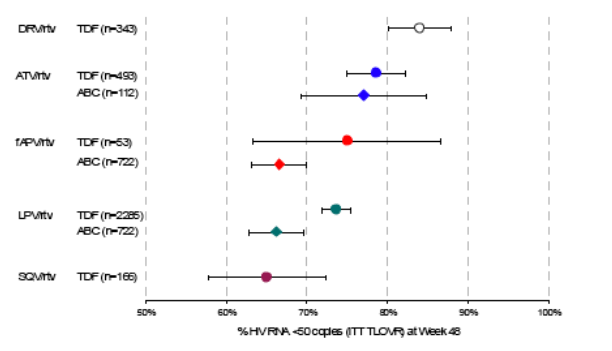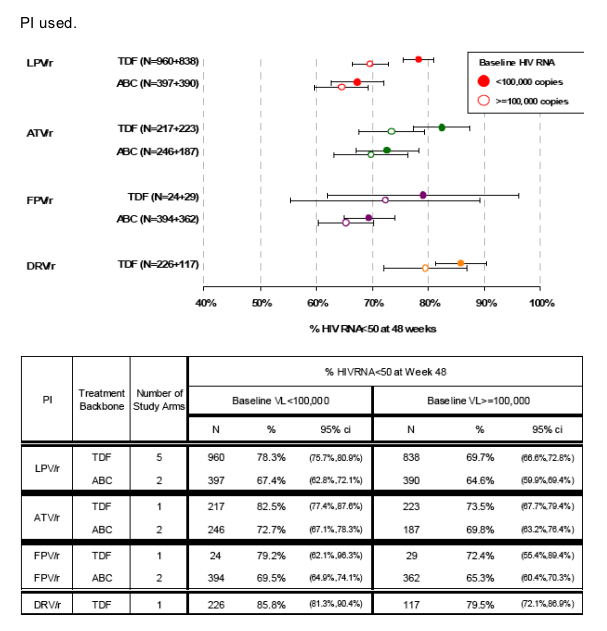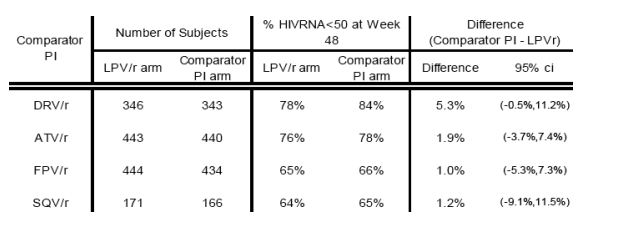 |
 |
 |
| |
Effects of NRTI backbone on efficacy of first-line boosted PI based HAART: meta-analysis comparing TDF to ABC
|
| |
| |
- systematic review of 12 clinical trials in 4896 patients
Reported by Jules Levin
ICAAC/IDSA Oct 27, 2008, Washington DC
Andrew Hill1, Will Sawyer2 1 Liverpool University, Liverpool, UK (e-mail microhaart@aol.com) 2 SEARCH, Bangkok, Thailand
BACKGROUND
Combinations of two NRTIs with a boosted PI are widely used as first-line HAART. There are conflicting results from clinical trials comparing TDF/FTC with ABC/3TC: the ACTG 5202 and BICOMBO trials suggested higher efficacy for TDF/FTC versus ABC/3TC, whereas the HEAT trial showed no efficacy difference between the NRTI backbones.
The purpose of this systematic review was to analyse the 48 week HIV RNA efficacy data from first-line clinical trials of ritonavir-boosted PIs by NRTI backbone in a standardized format.
(From Jules: the poster does not discuss pre-study HLA-B*5701 screening for genetic abacavir hypersensitivity in the trials and how this factors into the results of the studies and his analysis, and presumably genetic testing was not performed before these studies as this testing has recently been instituted.)
AUTHOR CONCLUSIONS
This systematic review of first-line clinical trials of 2NRTI + boosted PIs, with standardised HIV RNA <50 copy efficacy data, using the FDA TLOVR algorithm, suggests higher efficacy for first-line use of a TDF/FTC NRTI backbone, relative to use of ABC/3TC. This apparent difference in efficacy was seen for patients with baseline HIV RNA levels below and above 100,000 copies/mL. A similar difference in efficacy was shown in a systematic review of first-line trials of TDF/FTC/EFV versus ABC/3TC/EFV (Bartlett 2006).
Across the trials included in this systematic review, there were significantly lower HIV RNA suppression rates for patients with HIV RNA >100,000 at baseline (p=0.0003).
However this evidence does not have the strength of randomised comparative trials. With the TLOVR efficacy endpoint, the majority of treatment failures are discontinuations for non-virological reasons. Therefore, apparent differences in treatment efficacy between trials might be influenced by differences in trial procedures to manage adverse events, or maintain adherence.
There is conflicting evidence on the relative efficacy of TDF/FTC versus ABC/3TC from three direct head-to-head randomized trials. Two trials suggesting higher efficacy for TDF/FTC, and one trial shows non-inferior efficacy for ABC/3TC.
METHODS
A systematic MEDLINE review was conducted for prospective clinical trials of HAART regimens containing ritonavir-boosted Protease Inhibitors (PIs) in antiretroviral na´ve HIVinfected individuals published between January 1st, 2000 and March 1st, 2008.
HIV RNA suppression below 50 copies/mL at Week 48 was summarized using the Food and Drug Administration's Time to Loss of Virological Response (TLOVR) algorithm, or nearest equivalent endpoint available. Data on efficacy by baseline HIV RNA level was not available for all trials.
The meta-analysis pooled estimates for groups of studies using inverse-variance weighting. Pooled estimates of standard deviation included terms for both between and within-group variation. Efficacy estimates were adjusted for baseline log10HIV RNA and CD4 count using least squares from the ANOVA model.
Results - baseline characteristics


Figure 1 and Table 2 show summary HIV RNA efficacy data at Week 48 by NRTI and PI used. For patients taking either LPV/r, ATV/r or fAPV/r, the HIV RNA <50 efficacy at Week 48 appeared higher for trials including TDF/FTC, relative to those using ABC/3TC.

Results - efficacy by NRTI and PI used, stratified by baseline HIV RNA
Figure 2 and Table 3 show HIV RNA suppression rates below 50 copies/mL at Week 48 (ITT) by baseline HIV RNA. Results are shown for each individual trial. Across all the trials, HIV RNA suppression rates were significantly higher for those with baseline HIV RNA below 100,000 copies/mL (75.1%) versus below 100,000 copies/mL (68.7%) (p=0.0019, ANCOVA adjusting for PI used).

Figure 3 and Table 4 show overall HIV RNA response rates by PI and NRTI used, stratified by baseline HIV RNA level. There were trials of LPV/r, ATV/r and fAPV/r using either TDF/FTC or ABC/3TC. Over these three PIs, the HIV RNA responses were significantly lower when ABC/3TC was used, relative to TDF/FTC, for the lower baseline HIV RNA level (69.5% vs. 79.1%, p=0.0001) and borderline for the higher (65.9% vs. 70.6%, p=0.0995) after adjusting for the PI used.

Results - direct comparisons of PIs and NRTIs
Table 5 shows summary results from three randomised trials of TDF/FTC versus ABC/3TC. ACTG 5202 compared TDF/FTC versus ABC/3TC for na´ve patients who were also taking either EFV or ATV/r (primary endpoint virological failure). Only results from patients with HIV RNA >100,000 copies/mL are available. HEAT compared TDF/FTC/LPV/r versus ABC/3TC/LPV/r in treatment na´ve patients (primary endpoint HIV RNA<50 copies/mL at Week 48). BICOMBO compared TDF/FTC with ABC/3TC for patients with HIV RNA <50 copies/mL at baseline (primary endpoint HIV RNA <200 copies/mL at Week 48).

Table 6 shows summary results of randomised trials of four PIs with LPV/r: The comparator PI was DRV/r 800/100 mg OD in ARTEMIS, ATV/r 300/100 md OD in CASTLE, fAPV/r 700/100 mg BID in KLEAN and SQV/r 1000/100 mg BID in GEMINI. All trials showed non-inferior efficacy for the new PI versus LPV/r. ARTEMIS showed a significant efficacy benefit over LPV/r for patients with baseline HIV RNA >100,000 copies/mL (79% versus 67%, p<0.05).

References
BI 1182.33: Cooper D et al. HIV 8, Glasgow. Abstract PL13.4. 2006. 2. SHARE: Elion R et al. HIV Clin Trials 2008, 9: 152- 163 3. KLEAN: Eron J et al. Lancet, August 5, 2006; 368 (9534): 476-482. Abbott 730: Gathe J et al: 15th CROI, Boston, 2008 [abstr. 775] REDUCE: Hicks C et al: 11th EACS Madrid, Spain October 2007 [abstr PS 7.01] Abbott 418: Johnson M et al. J Acquir Immune Defic Syndr 2006, 43: 153-160 CASTLE: Molina J M et al. Lancet 2008, 372 : 646-655. ARTEMIS: Ortiz R et al. AIDS 2008, 22: 1389-1397. ALERT: Smith K et al. AIDS Research and Therapy 2008, 5:5 HEAT: Smith K et al. 15th CROI, February 2008, Boston, USA [abstr. 774] GEMINI: Walmsley S et al. EACS Madrid, Spain, 2007; abstract PS1/4. SOLO: Gathe J et al: AIDS 2004, 18: 1529-1537. Bartlett 2006. World AIDS conference Toronto, Canada [abstr THPE0111]
|
| |
|
 |
 |
|
|